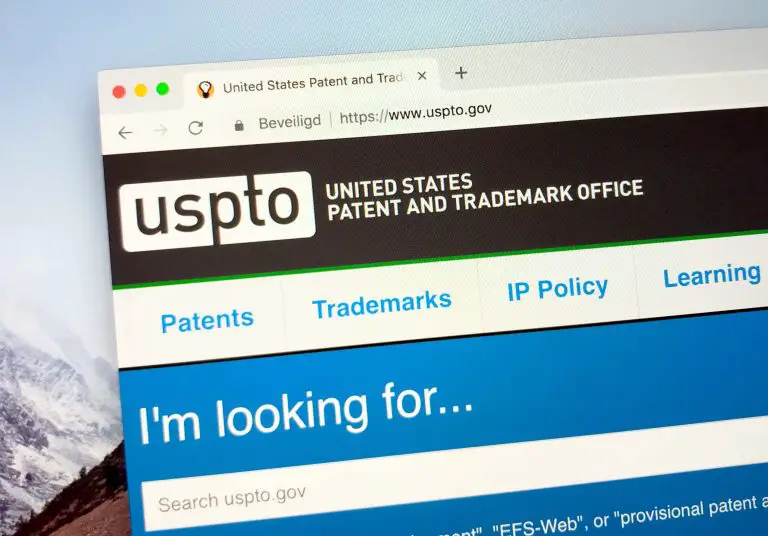How to Patent a Name?
If you have a name that you want to patent, we are sorry to tell you that you cannot patent a name. However, you are able to trademark a name by filing a trademark application with the USPTO (United States Patent and Trademark Office). Registering a name or mark with the USPTO is straightforward and we will show you how you can register your name/mark with the trademark office in the United States.
How to Patent a Name?
So, now you know that you cannot patent a name, you should know that you can protect it by registering as a trademark. You can register it as a trademark by filing a trademark application with the trademark office.
You can register a name as a trademark by following these steps:
- Heading over to USPTO.gov
- Performing a trademark search at USPTO Trademark Search to make sure the name you want to register is not already registered as a trademark
- If the name you want to trademark is not registered, you can prepare your trademark application at USPTO Trademark Application
The trademark application should not take you more than 45 minutes to prepare and submit. Many people will be able to prepare the application and submit it on their own, however, if there is something that you don’t understand, you should contact an attorney to assist you with the preparation and filing of your trademark application.
Patent Rebel Note: If the trademark that you want to register is already registered by someone else, the trademark office may reject your trademark application on the grounds that the registration of your mark will cause confusion with the already registered mark.
Requirements to Register a Name as a Trademark
To register a name as a trademark, an applicant must satisfy the following requirements:
- Provide information, such as the name of the applicant and owner of the name that he wants to register as a trademark,
- Provide the name of the individual or entity that owns the name to be registered as a trademark,
- Demonstrate that the owner of the name actually uses the name in connection with the sale of goods, products, or services,
- Demonstrate that the name to be registered is distinctive, meaning that consumers recognize the name as referring to you or your business as the source of goods, products, or services,
- Provide a description of the goods or services that you’re using the name to refer to. For example, if you’re using the name on software, provide a description of the software for which you’re using the name,
- Submit a specimen of the name or trademark you want to register,
- Provide the date on which you first commercially used the name as a trademark
Once you’ve compiled the information that you need for your application, you should prepare your application, file it with the USPTO, and pay the applicable filing fees directly to the USPTO.
Why Should You Trademark a Name?
1) Exclusive Use
You should trademark a name that you’re using to market goods or services because registering it allows you to be the exclusive person or business to use the trademark in connection with the offering of goods or services to the public.
Said differently, you will be the only one who can use the trademark on products or services that you’re offering to the public.
If anyone else uses the trademark on competing goods or services that confuses consumers, you will be able to file a lawsuit against them for trademark infringement to stop their infringing use of your trademark.
2) Deters Misuse
Registering your trademark with the trademark office warns others not to misuse your trademark by showing them that you’ve taken legal steps to legally protect your trademark.
The public will know that you’ve registered your trademark from the registered logo ® that must be placed on your trademark. Also, they can check by heading over to the USPTO website and performing an easy trademark search.
Since the public will know that you’ve registered your trademark, they will be less likely to misuse your trademark because they know that you’ve taken the necessary legal steps to protect it.
3) Ability to Bring Lawsuit
Although registering a trademark reduces the possibility that someone will misuse your trademark, it does not eliminate the risk entirely. That said, if a party does misuse your trademark in a way that confuses consumers as to the source of goods or services, you do have the ability to bring a lawsuit against the bad actor in Federal District Court for trademark infringement.
4) Nationwide Protection of Your Trademark
If you don’t register your trademark with the USPTO, your trademark will only be protected in the state in which your using your trademark. For example, if you’re using the name “Patent Rebel” for offering patent services in California, you’re only protected in California.”
Registering your trademark at the USPTO offers nationwide protection of your trademark. Going back to our previous example, if you’re using the mark “Patent Rebel” on patent services in California, you will still be covered across all states in the United States even though you’re not offering your services in those states.
This means, that if you intend on expanding offering services outside your state, registering your trademark means that your name or trademark is protected in all states.
5) Proof of Owning Your Trademark
Registering your trademark with the USPTO acts as prima facie evidence that you are the owner of your trademark. If you want to prove ownership of your trademark without federal registration, you will have to show that you’ve used the name or trademark in commerce on your goods or services (things become more difficult without federal registration).
This becomes very important if you bring a lawsuit against someone who is infringing upon your trademark. To prove ownership of your mark, you can simply submit proof of your registration and you’ve established prima facie evidence of registration. It is then up to the opposing party to prove evidence to the contrary.
How Much Does it Cost to Patent a Name?
According to the USPTO, to register a trademark, you should expect to pay between $225 to $400 per class of goods. So, how many classes of goods do you have to pay for?
The number of classes you have to pay for depends on how many different categories of products or services you want to register your trademark for.
For example, if you want to use your trademark on mugs and pens, you may need to pay for two classes of goods because they are different categories. So, the fee you will pay depends on how many classes of goods you want to register your trademark for.
If you prepare and file your trademark registration application by using the USPTO website, you will only need to pay the fees we mentioned above.
However, if you use a third-party service to assist you with the preparation and filing of your trademark application, you will need to pay additional fees for the use of such service.
Should You Patent or Trademark a Name?
You cannot patent a name because patent law only protects new inventions, machines, processes, and designs. Patent law does not protect names that an individual uses to identify the source of goods or services.
So, you can only protect a name that you’re using as a brand by registering it as a trademark with the USPTO.
How Do You Check if a Name is Trademarked?
You can check if a name is trademarked by heading over to the USPTO Trademark Checker Tool. This tool allows you to enter the name or trademark that you want to register and checks the trademark database for any similar results.
If your search returns any similar registered trademarks for the same class of goods or services that you want to use the trademark for, you should try to find a different name or trademark for your product or service.
If the search does not turn up any exact results, you should still make sure that your trademark is different enough than anything that’s registered to avoid trademark infringement.
What is the Difference Between a Trademark and a Patent?
A trademark is meant to protect words, logos, or symbols that a person uses to identify himself or his business as the source of goods or services.
Said differently, if you have a brand name or logo that you use on your products or services so that the public would recognize them as yours, you have a trademark on your hands.
The best way to protect a trademark is to register it with the USPTO as a trademark. Registration is not prohibitively expensive and it does have its benefits.
Patents, on the other hand, protect new and unique inventions, such as machines, compositions of matter, articles of manufacture, and designs.
Patenting an invention involves disclosing exactly how to make an invention to the public and in return for making such a disclosure, a patent holder is awarded a limited-time monopoly over his invention.
Where trademarks have the potential to last forever, patents only last for 15 to 20 years, depending on the type of patent that you opt for.
Patent Rebel Frequently Asked Questions (FAQs)
1) Can anyone trademark a name?
Anyone who uses a name or a mark to identify himself or his business as the source of a product, good or service will be able to register his name or mark as a trademark with the trademark office so long as no one else has already registered the same mark or a confusingly similar mark to the one that you want to register. You can check to see if anyone has registered the mark that you want to register by performing a trademark database search at the USPTO website.
2) Can you use a name that is trademarked?
You can use a name that is trademarked so long as the class of goods for which you’re registering your trademark is so different than the registered mark that you using it on your goods or services will not confuse the public as to the source of goods or services.
That said, it’s best to avoid using a registered trademark to avoid any legal trouble down the road. This is so because if the trademark owner feels that your mark is too similar to theirs, they might sue you for trademark infringement. As such, it’s best to use a mark that is not registered.
3) Can you patent a name for free?
At this point, you should know that you cannot patent a name, instead, you can register it as a trademark with the trademark office. Unfortunately, you cannot register a trademark for free. The USPTO does charge a fee that ranges from $225 to $400 to register a single trademark.
4) Can two people register the same name?
Two people can register or trademark the same name so long as that the second person registering the mark is registering it for a totally different class of goods or services that will not confuse the public as to the source of goods or services. For example, someone has registered the trademark rebel for patent services and you want to register the trademark rebel for music equipment, you probably will have success registering your mark because the two categories are so different that your registering of the mark is unlikely to confuse consumers as to the source of goods or services.








